The messenger in onboard serves as a communication hub for communicating with your employees.
Access to the Messenger
Access via employee file
- Click on “Employee files” in the side menu and then select a desired status
- Click on the desired employee file
- You are now in the overview of the employee file
- You will find the Messenger in the white ribbon
- You will now see the chat interface of the messenger
In the chat interface, you can see the entire message history with this person. This includes all messages that you have sent or received, as well as the corresponding attachments.
It is important to understand that the messages you write and send in onboard Messenger will arrive at the recipient as a normal email, unless the employee has access to their file and Messenger. If they then write an email back, the message is automatically imported into your messenger.
If your employees can view their own file via basic access, Messenger is available to them as an internal chat tool.
This makes handling correspondence much more user-friendly, intuitive and clearer for you as a user.
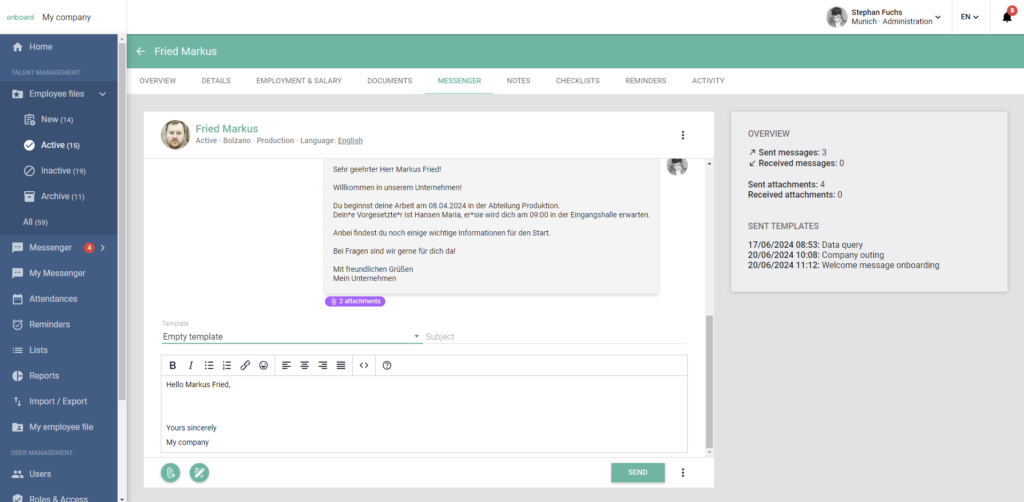
Access via main menu item “Messenger”
- In the side menu on the left under “Talent Management”, click on the menu item “Messenger” – “Chats”
- You are now in the general messenger
- On the left you will see a list of all employees with whom you have already been in contact
- You can search for employees, filter them or start new conversations using the “+” button:
In the pop-up above the “+” button, you can search for individual employees or select several, click “Next” to go to the chat interface - If you click on an employee, the chat interface opens on the right-hand side
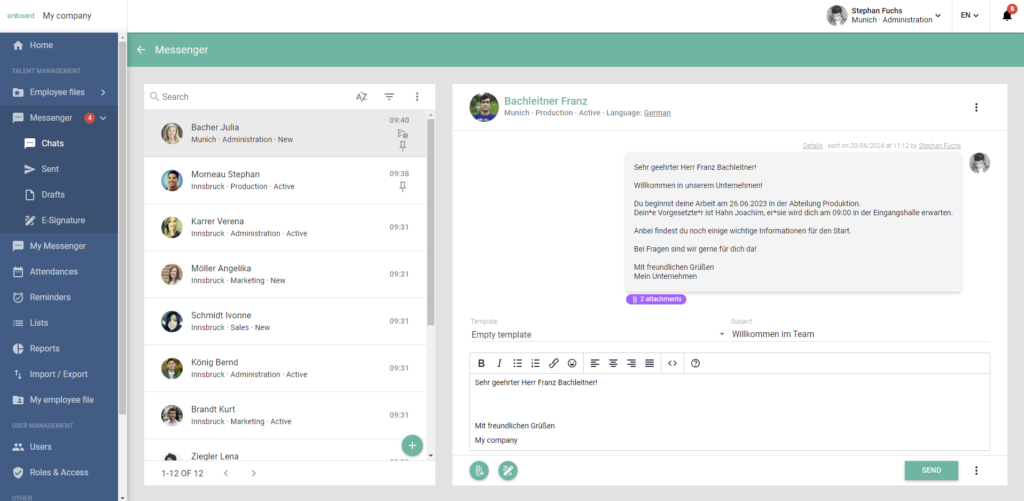
Using the messenger
Sending messages
- Open the chat interface either via the “Messenger” menu item or an employee file
- To compose a message, click in the message field
- There is a predefined “empty template” that can be used to quickly write messages, in which the form of address and greeting are already stored as placeholders (edit in the settings)
- On the right above the message box you will find the subject, which you can customise
- A saved message template can be selected to the left of this
- You can use placeholders for instant dispatch via the “(?)” icon
- You can attach files using the paper clip:
The uploaded files can be managed by clicking on them - You can use the “pencil” icon to the left of the paper clip to select the signature thickness for signing attached documents (if you have the “Electronic signature” add-on module)
- No headers and footers appear in the chat interface to keep the writing process clearer; you can see the complete message via the three action points -> Preview, here you can return to editing or send the message immediately
- You can also use the three action points at the bottom right to:
- open an extended view to get more space for writing and, if necessary, to add a blind copy address
- Use the translator (if several languages are active and the applicant does not speak the user’s system language)
- select a time before the message is sent later (these messages are specially marked)
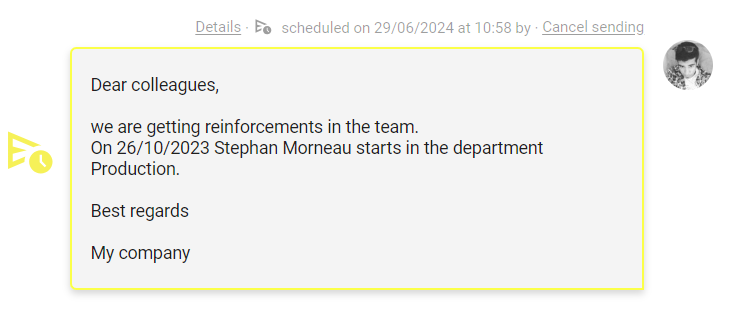
- Sending via “Send” must always be confirmed manually
You can see above the sent message which user sent it. You can view the complete message via “Details” and cancel the delayed sending.
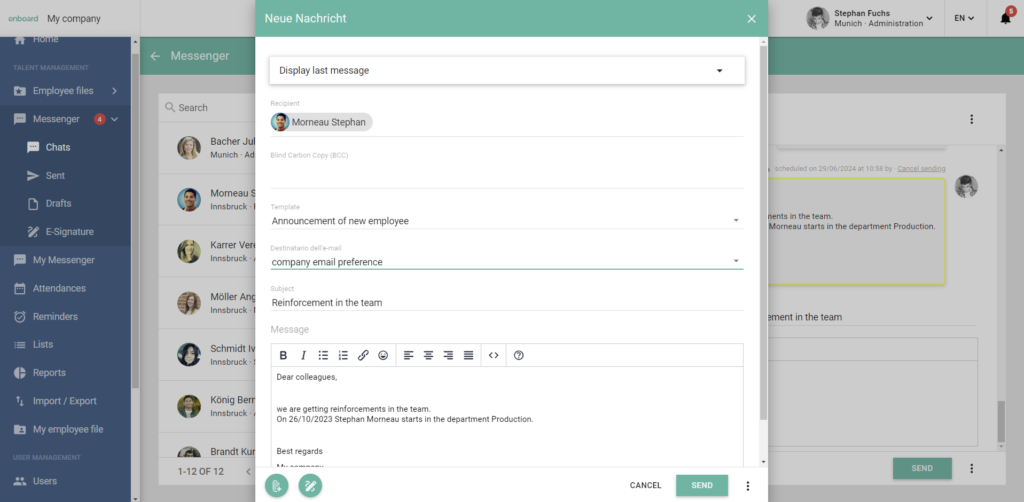
Dispatch status of the message
Drafts
In this message status, you will find all messages that have been started but not yet finished. By clicking on the three action points in the list, you can open, edit and send or remove the message.
Sent messages
Here you will find an overview of all sent or scheduled messages and can duplicate and resend them if necessary using the three action points.
E-signature
If you are using the additional module for electronically signing documents, this status provides you with an overview of the signature status.
Documents
Documents that you receive via Messenger are automatically filed in the employee file under “Documents” – “Other documents”. They can also be managed and deleted here.
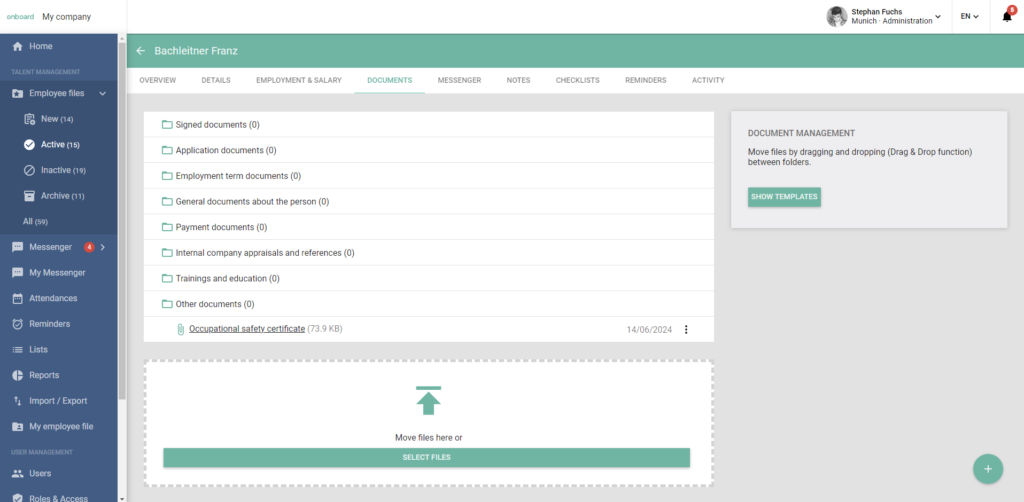
Dispatch via the “Messenger” menu item
In the “Messenger” menu item, you will find a list of conversations that have already been started.
Employees with whom you have not yet communicated are excluded from the list. If you want to write to these employees, you can start the conversation via the employee file or via the “+” button in the “Messenger” menu item.
To continue an active conversation, simply click on the employee in the employee list and the chat will open on the right.
Filters
You can filter the chats according to the following categories:
Status of the message
Read
You can filter to see all messages, only unread messages or only read messages.
Unanswered
You can filter to see all messages, only answered messages or only unanswered messages. Only unanswered messages can also be messages that have already been read but not answered.
Archived
You can use this filter to show archived messages that have been hidden.
Scheduled
You can filter to see all, only scheduled or only unscheduled messages.
Started
You can filter to see all, started or not started messages. By default, the “Started” filter is set here to show only active conversations.
Status of the employee
Filter according to the status of your employees, in which the employee file is located in the side menu on the left.
Locations
Filter by the locations of your company.
Departments
Filter by the departments of your company.
Sorting
You can change the sorting of your chats using the “AZ” symbol:
- New chats first (default setting)
- Unread chats first
Message status
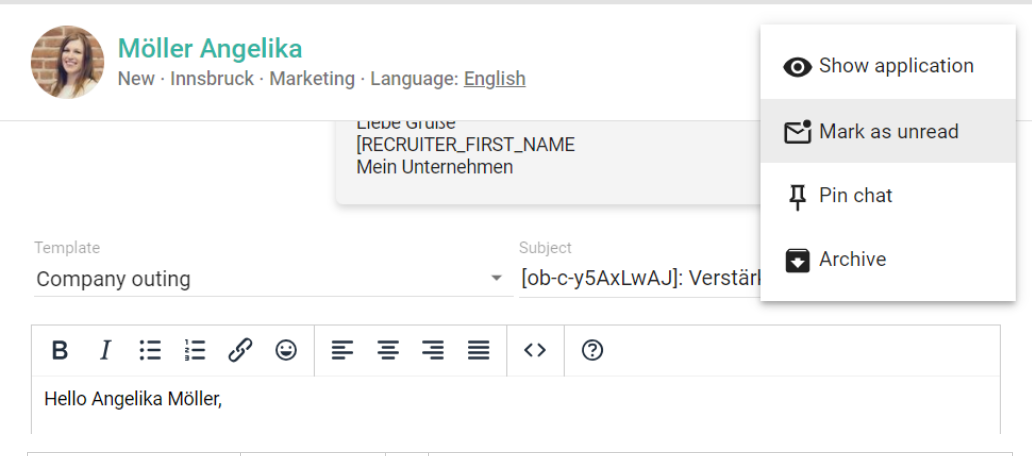
Read and unread
A newly received message has the status “unread” by default and is therefore highlighted in red.
As soon as you click on this message, the red marking disappears and the message is now “read”.
You can change the status back to “unread” by clicking on the three action points next to the employee name and selecting “Mark as unread”.
Fix chat
This status is global and thus fixes the conversation with a specific employee at the top of the employee list. The chat can be deleted afterwards.
Archive
If you want to close the conversation with an applicant, you can archive it. This process removes the chat from the employee list in the “Messenger” menu item and is therefore global for all users.
The chat is still in the employee file and will not be deleted.
Dispatch to multiple recipients
Via the menu item “Employee files”
Click on a desired status under “Employee files” and activate multiple selection via the three action points.
Now select all the desired employees and select the “Send message” option under “Select action”.
The chat interface will now open, you will not see any names here but only placeholders because you have selected several people. Don’t forget to check the translations or add to them if you write more text in the message. Additional employees can be added via the recipient button. Simply type in the name.
You can use the three action points -> “Preview” to view the messages with the correct salutations and names before sending them.
Via the main menu item “Messenger”
You can start new conversations via the “+” button in the Messenger menu item.
Search for the desired employees here or select them from the list. You can also filter them.
Click on “Next” to go to the chat interface.
Sending group messages
This function will be available soon.
Notifications and accesses
Notifications
If you receive messages from employees, you will see them directly in onboard. To alert you to new messages, you will receive an e-mail notification from onboard once or twice a day, depending on your settings. In the system, you will receive the notification via the bell at the top right. We also show you new messages in the Messenger menu item, and you can see how many new messages are waiting for you as soon as you enter onboard.
New messages in onboard are displayed individually as unread for each user with the appropriate authorisation, even if other users in the system have already replied to them.
Roles and access
In the settings, you can clearly define who can and cannot access the messenger.
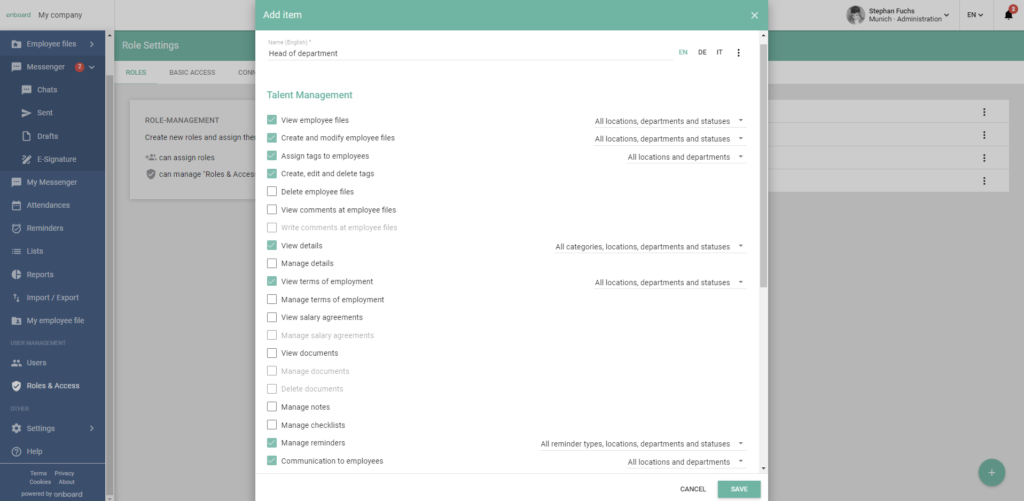
Frequently asked questions
How often are messages received and sent?
Messages are sent immediately and our servers are synchronised every few minutes to receive them.
How does sending via Messenger work?
Your company will receive an individual e-mail address for sending and receiving messages. Your chosen sender name is visible to employees when they receive the messages.
How can I quickly mark several messages as read?
Filter by “Message status” -> “unread” and “unanswered” -> “answered” at the same time. You will now only see messages that you have not yet read but that other users have already replied to.
Now activate the multiple selection via the three action points and select all messages.
Under “Select action” you can mark the messages as “read”.
Can I integrate a video into my e-mail?
In most cases, embedding video files for direct playback in the email is not supported by the email programmes and is blocked.
As an alternative, however, an image (e.g. a screenshot of the video) could be inserted in the e-mail and linked to the video.

